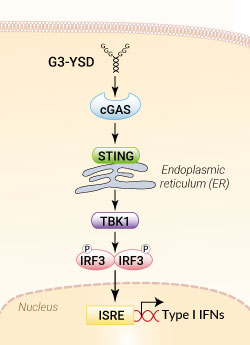G3-YSD
| Product | Unit size | Cat. code | Docs. | Qty. | Price | |
|---|---|---|---|---|---|---|
|
G3-YSD Y-form DNA - cGAS agonist |
Show product |
200 µg |
tlrl-ydna
|
|
cGAS Agonist
G3-YSD (G3-ended Y-form Short DNA) is a 26-mer DNA sequence derived from the HIV-1 RNA genome [1]. This short DNA displays a Y-shape arising from its palindromic sequence flanked by unpaired guanosine trimers (G3). The guanosine overhangs in this Y-form DNA have been identified as minimal recognition motifs for cGAS (cyclic GMP-AMP synthase, cGAMP synthase), a critical cytosolic DNA sensor [1].
Mode of action:
cGAS detects double-stranded DNA (dsDNA) over 40 bp in length, or stem-loop structures of single-stranded DNA (ssDNA) flanked by unpaired nucleotides [1-3]. Interaction of cGAS with its agonists promotes the synthesis of 2’3’-cGAMP, a second messenger that activates STING (stimulator of interferon genes), and the downstream production of type I interferons (IFNs) and other cytokines [2]. Response to G3-YSD is strictly cGAS-dependent, as demonstrated by the lack of type I IFN production upon intracellular delivery of G3-YSD in cGAS-KO cells (see figures).
Key features of G3-YSD:
- Potent cGAS-specific agonist
- Y-form Short DNA flanked with guanosine trimers
- Each lot is functionally tested
![]() Read our review on cGAS.
Read our review on cGAS.
References:
1. Herzner A.M. et al., 2015. Sequence-specific activation of the DNA sensor cGAS by Y-form DNA structures as found in primary HIV-1 cDNA. Nat Immunol. 16(10):1025-33.
2. Li T. & Chen Z.J., 2018. The cGAS-cGAMP-STING pathway connects DNA damage to inflammation, senescence, and cancer. J Exp Med.215(5):1287-1299.
3. Luecke S. et al., 2017. cGAS is activated by DNA in a length-dependent manner. EMBO Rep. 18(10):1707-1715.
Specifications
Activity: cGAS agonist
Working concentration: 100 ng - 1 μg/ml
Sequence: 5’ GGG TATATATATGCATATATATA GGG 3’ (26 mer)
Note: G3-YSD contains a palindromic sequence for which self-hybridization results in double-stranded DNA. The flanking guanosine trimers in 5' and 3' remain unpaired.
Molecular weight: 8088.1 g/mol
Control: G3-YSD Control
Quality control:
- The biological activity has been verified using cellular assays.
- The absence of bacterial contamination, such as lipoproteins and endotoxins, has been confirmed using HEK-Blue™ TLR2 and HEK-Blue™ TLR4 cells.
Contents
- 200 μg G3-YSD (G3-ended Y-form Short DNA)
- 1.5 ml sterile endotoxin-free water
![]() G3-YSD is shipped at room temperature.
G3-YSD is shipped at room temperature.
![]() Upon receipt, store at -20°C.
Upon receipt, store at -20°C.
![]() Resuspended product is stable for 12 months at -20°C.
Resuspended product is stable for 12 months at -20°C.
![]() Avoid repeated freeze-thaw cycles.
Avoid repeated freeze-thaw cycles.
Details
cGAS
Cyclic GMP-AMP synthase (cGAS, cGAMP synthase) is a critical cytosolic DNA sensor that triggers innate immune responses through the production of type I interferons (IFNs) [1]. In response to cytosolic double‑stranded DNA (dsDNA), cGAS produces the cyclic dinucleotide (CDN) 2’3’-cGAMP.
CDNs bind directly to STING, leading to TBK1‑IRF3-mediated activation of IFN-stimulated response elements (ISRE) in the promoters of IFN-stimulated genes (ISG). The most potent agonist of human STING is 2’3’-cGAMP [2,3].
References:
1. Sun L. et al., 2013. Cyclic GMP-AMP synthase is a cytosolic DNA sensor that activates the type I interferon pathway. Science 339(6121):786-91.
2. Gao P. et al., 2013. Cyclic [G(2’,5’)pA(3’,5’)p] is the metazoan second messenger produced by DNA-activated cyclic GMP-AMP synthase. Cell. 153(5):1094-107.
3. Ablasser A. et al., 2013. cGAS produces a 2’-5’-linked cyclic dinucleotide second messenger that activates STING. Nature. 498(7454):380-4.









